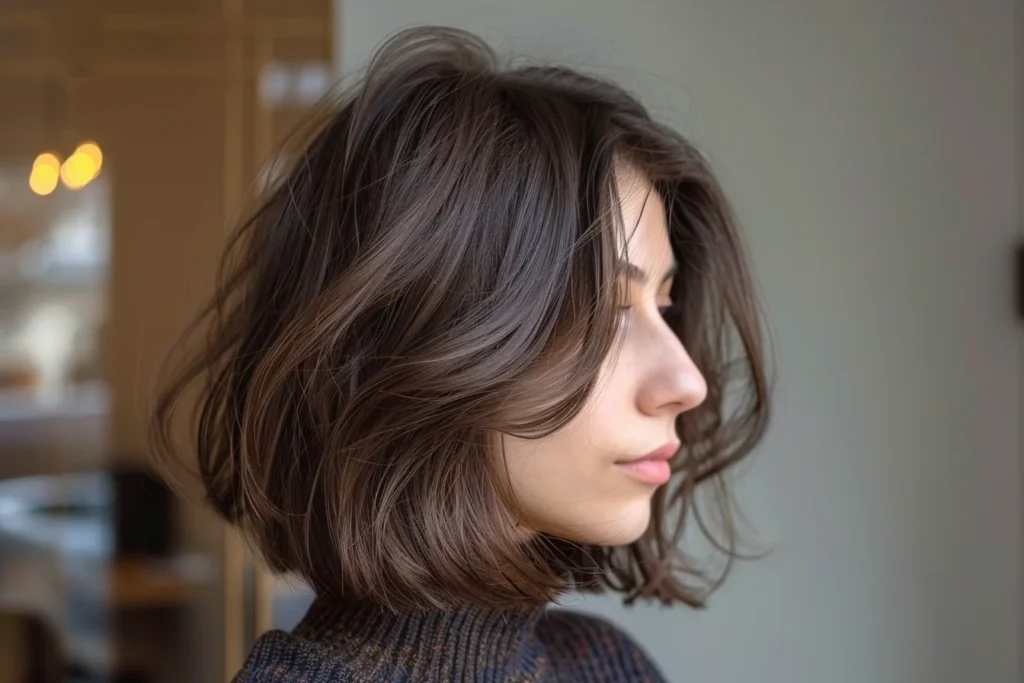Recognizing why your hair feels like hay is the initial step to bringing back its softness and liveliness. Many things can make hair dry and brittle.
It could be caused by anything from external factors such as sun exposure or chlorine in swimming pools, to internal causes like malnutrition or genetics.
The following paragraphs will discuss some of the most common reasons for straw-like hair texture.
We will explore different elements including care practices, environmental stressors, chemical treatments used on hairs, and genetic predispositions that may affect their healthiness or sleekness.
Hair Care Practices

Our hair’s texture and health are greatly influenced by how we take care of them. While everyone desires beautiful shiny locks, unfortunately, some habits can leave one with a feeling of having a dry unhealthy-looking straw for hair.
One main culprit is too much use of heat-styling tools like flat irons, curling wands, or blow driers.
High temperatures denature proteins found in human cells leading to loss of water content within those cells thus making them dehydrated and brittle hence breaking easily.
Besides this fact frequent application of heat on any part damages cuticles – the outermost layer of strands which appear rough when touched hence resembling straw since they lack smoothness brought about by intact cuticle structure.
Another mistake commonly committed during personal hygiene routine is over-washing our hair.
People think that cleaning scalps should be done daily but ideally, it should not exceed thrice per week because natural oils secreted help in lubricating shafts thus preventing loss of moisture through evaporation which would leave them dry and lifeless looking just like straws do.
There exists a wide variety of shampoos designed differently depending on the type each has its effect when used wrongly they might worsen the situation leading to more serious damage.
Environmental Aspects
In terms of our hair, environmental factors have a great impact on its health and feel making it appear like a straw.
For example, sun exposure can damage the hair cuticle which then becomes dry, brittle, and breaks easily.
The protein structure of hairs is broken down when UV rays enter into the shaft thus leaving it without moisture hence a rough texture similar to straw.
Further damages may be caused by continuous contact with extreme weather conditions such as high winds or very low temperatures hence making them parched and dull.

In addition, pollution in the environment could also affect hair condition leading to its feeling like straw.
Dust from industries together with smoke produced can accumulate on a person’s scalp weighing it down thus giving rise to coarseness besides roughness.
RELATED: How to Maintain Long Hair and Keep It Healthy
These substances strip off natural oils found on hairs thereby drying them out and leaving them susceptible to breakage while hard water that contains calcium ions deposits minerals onto strands making them stiffer than usual which gives one an impression of having used hay for bristles.
To avoid much harm being done by external factors on our tresses; hats should be worn, and scarves tied around them tightly, especially during windy days.
But if any other protective measures fail then thorough rinsing after exposure would suffice towards minimizing damages caused by these elements so as to maintain the softer and smoother look.
Nutrition’s role
Our diet greatly affects all aspects of general body health including skin quality where a lack of some vitamins minerals proteins make this part feel like a straw too.
Some essential nutrients required for healthy growth prevention dryness brittleness include vitamin E biotin omega-3 fatty acids among others hence must be taken in the right amounts always.
For instance, keratins needed most by locks are produced through the help given from antioxidants (vitamin E) which guard against free radicals attacking follicles.
Moisture retention becomes possible due to the biotin presence that supports its synthesis into different types of cells throughout this region but mainly those responsible for producing hairs.
Also, iron zinc minerals are necessary when it comes to thickness growth since if they become deficient then one may start experiencing loss or thinning out of strands hence causing a rough feeling.
Fruits, vegetables lean proteins healthy fats should always feature in our menu so that we remain nourished thereby keeping a soft smooth touch on them always
Chemical treatments
Hair can feel like straw because of chemical treatments. Such procedures are likely to damage and dehydrate the structure of hair to a great extent.
For instance, bleaching entails the application of strong chemicals to remove natural pigment from hair which makes it weak and dry.
Hair that has been bleached is often rough to touch and looks like straw more so if necessary precautions are not taken during aftercare.
Perming or relaxing also uses powerful chemicals which may make strands very coarse or rough hence appearing straw-like in texture.

The use of permanent or semi-permanent dyes when coloring one’s hair could also contribute to its feeling straw-like especially if already damaged or left on for too long.
These substances alter the pH balance of hairs besides stripping off the outer covering that protects them thereby causing dryness as well as breakage. Additionally, frequent dying compounds this problem over time resulting in brittle unmanageable locks.
To prevent chemically treated hair from turning into a baleful broomstick it is important to take preventive measures as well as follow correct post-treatment care methods.
This among others includes using mild shampoos without sulfate salts designed specifically for colored/chemically processed hairs together with regularly applying deep-conditioning masks and other treatments meant to add moisture to them while restoring any damaged parts to their original state again.
Reducing frequency through consulting an expert stylist who should be able to minimize destructions caused by these processes thus keeping our manes healthier-looking softer-feeling than ever before.
This could also do us some good since they have all the knowledge required in this field at their disposal thereby enabling one to achieve such results easily without much struggle being involved on his/her part whatsoever.
Hair type & genetics
Why does hair feel like straw? The answer lies within our genetic makeup combined with different types of textures present around us within society today.
But what role does genetics play when determining whether someone’s locks will feel coarse or not? These are some things you may want to consider.
Individuals born with thin/fine hairs have higher chances of getting straw-like strands because their hair shafts are naturally smaller in diameter than those people having thick/coarse hairs.
Besides, certain hair types such as wavy/kinky ones tend to become dry easily due to a lack of enough oil produced by sebaceous glands located on the scalp which struggle to reach tips since they have a longer distance travel down curly/wavy locks compared straight strands.
RELATED: Essential Oils for Boosting Hair Strength and Enhancing Growth
On the other hand, genes also determine how healthy one’s mane looks like; thus some individuals inherit weak brittle dryness-prone fibers whose appearance resembles hay more often than others.
Various genetic disorders exist that can make your tresses react differently towards heat chemicals or environmental stressors. This creates an illusion that they are damaged when in actual sense it is just natural for them based on our unique makeup.
As humans live within different climatic zones worldwide which expose us all to varying temperatures throughout the year round so what works well for someone might not necessarily work best for another person living at opposite ends earth.
From where we reside currently but still share the same race/ethnicity hence affecting the overall outcome achieved after using certain products meant improving the condition of these locks since no two individuals’ situations are alike concerning this matter under any circumstances whatsoever.
Regardless of whether one has good or bad genes for hair growth, there remains much more that needs doing towards taking care of oneself especially if looking forward to seeing healthier-looking softer-feeling manes staring back at us every time we look mirror during our morning routine before heading off school/work day.
Remedies and Prevention

Remedies and prevention strategies are essential for addressing and avoiding hair that feels like straw. One crucial aspect of prevention is adopting a gentle and nourishing hair care routine.
This includes using sulfate-free shampoos and conditioners specifically formulated to hydrate and strengthen the hair without stripping away its natural oils.
Additionally, incorporating weekly deep conditioning treatments or hair masks enriched with moisturizing ingredients like argan oil, shea butter, or coconut oil can help replenish lost moisture and improve the overall texture of the hair.
Protective styling can also play a significant role in preventing hair from feeling like a straw, especially for individuals who frequently use heat styling tools or undergo chemical treatments.
Utilizing heat protectant sprays or serums before heat styling can help minimize damage and preserve the hair’s moisture levels. Furthermore, opting for hairstyles that minimize manipulation and tension, such as braids, twists, or buns, can help protect the hair from breakage and dryness.
Maintaining a balanced diet rich in vitamins, minerals, and protein is another essential aspect of preventing hair from feeling like a straw.
Eating a variety of nutrient-dense foods such as fruits, vegetables, lean proteins, and healthy fats can provide the essential nutrients needed for healthy hair growth and maintenance.
Staying hydrated by drinking an adequate amount of water each day can help keep the hair hydrated from the inside out.
By incorporating gentle hair care practices, protective styling techniques, and a nutrient-rich diet into your routine, you can help prevent hair from feeling like straw and promote overall hair health and vitality.
Consistency and patience are key, as it may take time to see improvements, but with dedication and proper care, you can achieve soft, smooth, and manageable hair.
Solutions and Preventions
Regarding solutions and prevention, we should know that it is necessary to deal with straw-like hair.
One useful prevention is establishing a hair care routine that is gentle and nourishing. In detail, this implies using shampoos and conditioners without sulfate which are made to add moisture and strengthen the hair while not eliminating its natural oils.
It’s also recommended to add deep conditioning treatments or hair masks into our weekly beauty regimen; these should be saturated with argan oil, shea butter, or coconut oil because they help restore lost moisture and enhance overall hair softness.
Protective styling can do wonders when it comes to preventing straw-like locks, especially for those who subject their strands to heat styling tools often or have them chemically treated.
Before heat styling, one should make use of heat protectant sprays or serums to minimize damage caused by excess temperatures as well as preserve adequate levels of moisture within the strands.
Additionally, styles that cause less manipulation and tension such as braids, twists, or buns are highly advised since they shield against breakage which may result from dryness too.
A good dieting strategy is essential in stopping hair from becoming a straw.
To this end, consuming different types of nutrient-dense meals including fruits vegetables lean proteins healthy fats among others will provide all necessary building blocks required for optimal growth and maintenance of healthy-looking tresses.
We should not overlook hydration if at all we want our hair to remain supple instead of resembling dried hay.

